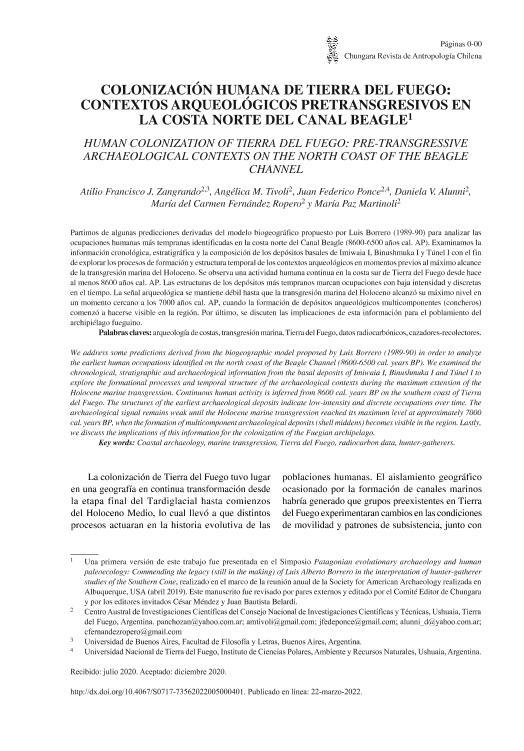Mostrar el registro sencillo del ítem
dc.contributor.author
Zangrando, Atilio Francisco Javier

dc.contributor.author
Tivoli, Angelica Montserrat

dc.contributor.author
Ponce, Juan Federico

dc.contributor.author
Alunni, Daniela Verónica

dc.contributor.author
Fernández Ropero, María del Carmen

dc.contributor.author
Martinoli, Maria Paz

dc.date.available
2023-04-17T15:46:16Z
dc.date.issued
2022-03
dc.identifier.citation
Zangrando, Atilio Francisco Javier; Tivoli, Angelica Montserrat; Ponce, Juan Federico; Alunni, Daniela Verónica; Fernández Ropero, María del Carmen; et al.; Colonización humana de Tierra del Fuego: Contextos arqueológicos pretransgresivos en la costa norte del Canal Beagle; Universidad de Tarapacá; Chungará; 54; 3; 3-2022; 557-577
dc.identifier.issn
0717-7356
dc.identifier.uri
http://hdl.handle.net/11336/194197
dc.description.abstract
Partimos de algunas predicciones derivadas del modelo biogeográfico propuesto por Luis Borrero (1989-90) para analizar las ocupaciones humanas más tempranas identificadas en la costa norte del canal Beagle (8600-6500 años cal. AP). Examinamos la información cronológica, estratigráfica y composición de los depósitos basales de Imiwaia I, Binushmuka I y Túnel I con el fin de explorar los procesos de formación y estructura temporal de los contextos arqueológicos enmomentos previos al máximo alcance de la transgresión marina del Holoceno. Se observa una actividad humana continua en la costa sur de Tierra del Fuego desde hace al menos 8600 añoscal. AP. Las estructuras de los depósitos más tempranos marcan ocupaciones con baja intensidad y discretas en el tiempo. La señal arqueológica se mantiene débil hasta que la transgresión marina del Holoceno alcanzó su máximo nivel en un momento cercano a los 7000 años cal. AP, cuando la formación de depósitos arqueológicos multicomponentes (concheros) comenzó a hacerse visible en la región. Por último, se discuten las implicaciones de esta información para el poblamiento del archipiélago fueguino.
dc.description.abstract
We address some predictions derived from the biogeographic model proposed by Luis Borrero (1989-90) in order to analyze the earliest human occupations identified on the north coast of the Beagle Channel (8600-6500 cal. years BP). We examined the chronological, stratigraphic and archaeological information from the basal deposits of Imiwaia I, Binushmuka I and Túnel I to explore the formational processes and temporal structure of the archaeological contexts during the maximum extension of the Holocene marine transgression. Continuous human activity is inferred from 8600 cal. years BP on the southern coast of Tierra del Fuego. The structures of the earliest archaeological deposits indicate low-intensity and discrete occupations over time. The archaeological signal remains weak until the Holocene marine transgression reached its maximum level at approximately 7000 cal. years BP, when the formation of multicomponent archaeological deposits (shell middens) becomes visible in the region. Lastly, we discuss the implications of this information for the colonization of the Fuegian archipelago.
dc.format
application/pdf
dc.language.iso
spa
dc.publisher
Universidad de Tarapacá
dc.rights
info:eu-repo/semantics/openAccess
dc.rights.uri
https://creativecommons.org/licenses/by-nc-sa/2.5/ar/
dc.subject
ARQUEOLOGIA DE COSTAS
dc.subject
TRANSGRESION MARINA
dc.subject
TIERRA DEL FUEGO
dc.subject
DATOS RADIOCARBONICOS
dc.subject
CAZADORES-RECOLECTORES
dc.subject.classification
Arqueología

dc.subject.classification
Historia y Arqueología

dc.subject.classification
HUMANIDADES

dc.title
Colonización humana de Tierra del Fuego: Contextos arqueológicos pretransgresivos en la costa norte del Canal Beagle
dc.title
Human colonization of Tierra del Fuego: Pre-transgressive archaeological contexts on the north coast of the Beagle Channel
dc.type
info:eu-repo/semantics/article
dc.type
info:ar-repo/semantics/artículo
dc.type
info:eu-repo/semantics/publishedVersion
dc.date.updated
2023-04-17T11:03:02Z
dc.journal.volume
54
dc.journal.number
3
dc.journal.pagination
557-577
dc.journal.pais
Chile

dc.journal.ciudad
Santiago de chile
dc.description.fil
Fil: Zangrando, Atilio Francisco Javier. Consejo Nacional de Investigaciones Científicas y Técnicas. Centro Austral de Investigaciones Científicas; Argentina. Universidad de Buenos Aires. Facultad de Filosofía y Letras; Argentina
dc.description.fil
Fil: Tivoli, Angelica Montserrat. Consejo Nacional de Investigaciones Científicas y Técnicas. Centro Austral de Investigaciones Científicas; Argentina
dc.description.fil
Fil: Ponce, Juan Federico. Consejo Nacional de Investigaciones Científicas y Técnicas. Centro Austral de Investigaciones Científicas; Argentina
dc.description.fil
Fil: Alunni, Daniela Verónica. Consejo Nacional de Investigaciones Científicas y Técnicas. Centro Austral de Investigaciones Científicas; Argentina. Universidad Nacional de Tierra del Fuego, Antártida e Islas del Atlántico Sur. Instituto de Ciencias Polares, Ambientales y Recursos Naturales; Argentina
dc.description.fil
Fil: Fernández Ropero, María del Carmen. Consejo Nacional de Investigaciones Científicas y Técnicas. Centro Austral de Investigaciones Científicas; Argentina
dc.description.fil
Fil: Martinoli, Maria Paz. Consejo Nacional de Investigaciones Científicas y Técnicas. Centro Austral de Investigaciones Científicas; Argentina
dc.journal.title
Chungará
dc.relation.alternativeid
info:eu-repo/semantics/altIdentifier/doi/http://dx.doi.org/10.4067/S0717-73562022005000401
dc.relation.alternativeid
info:eu-repo/semantics/altIdentifier/url/https://www.scielo.cl/scielo.php?pid=S0717-73562022000300557&script=sci_abstract
Archivos asociados
